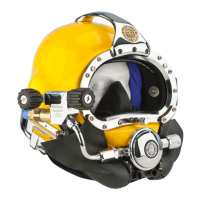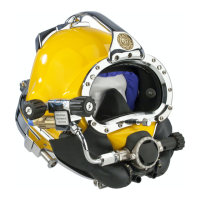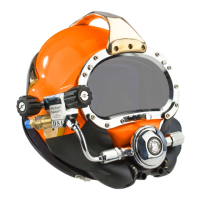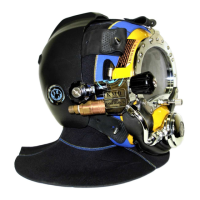Diving with compressed breathing gas is a hazardous activity. Even if you do everything
right there is always the danger that you may be killed or injured. No piece of diving
equipment can prevent the possibility that you may be killed or injured any time you
enter the water.
SuperLite
®
27
®
Helmet
Operations and Maintenance Manual
KMDSI Part # 100-027
Kirby Morgan Dive Systems, Inc.
1430 Jason Way
Santa Maria, CA 93455, USA
Telephone (805) 928-7772, FAX (805) 928-0342
E-Mail: KMDSI@KirbyMorgan.com, Web Site:www.KirbyMorgan.com
Manual prepared by Marine Marketing and Consulting, Dive Lab, Inc., and KMDSI.
NOTE: This manual is the most current for the SuperLite
®
27
®
Helmet. It is page dated January 2013. Future
changes will be shown on page III and the changed pages will carry the date of change. Previous manuals may not
reect these updates.
™
Document Number 130115001
Kirby Morgan, SuperLite
®
, BandMask, Band Mask, KMB, KMB-Band Mask, DSI, Diving Systems International, EXO, REX
®
,
SuperFlow
®
and DECA are all registered trademarks of Kirby Morgan Dive Systems, Inc. Use of these terms to describe products
that are not manufactured by KMDSI is illegal.
The two dimensional images (such as photographs and illustrations) of our products are © copyrighted and trademarks of Kirby
Morgan Dive Systems, Inc. The three dimensional forms of our products are trademark, trade design and trade dress protected.
© ⅯⅯⅩⅡ Kirby Morgan Dive Systems, Inc. All rights reserved. This manual is made available for the express use of the owner of
this Kirby Morgan product. No part of this manual may be reproduced, stored in any retrieval system, or transmitted, or used in any
form or by any means, whether graphic, electronic, mechanical, photocopy, or otherwise by technology known or unknown, without
the prior written permission of Kirby Morgan Dive Systems, Inc.
The SuperLite
®
27
®
helmet is CE Approved and meets or exceeds all performance and testing require-
ments of all government and non-government testing agencies throughout the world. It is approved
for use on all commercial and military work underwater.




